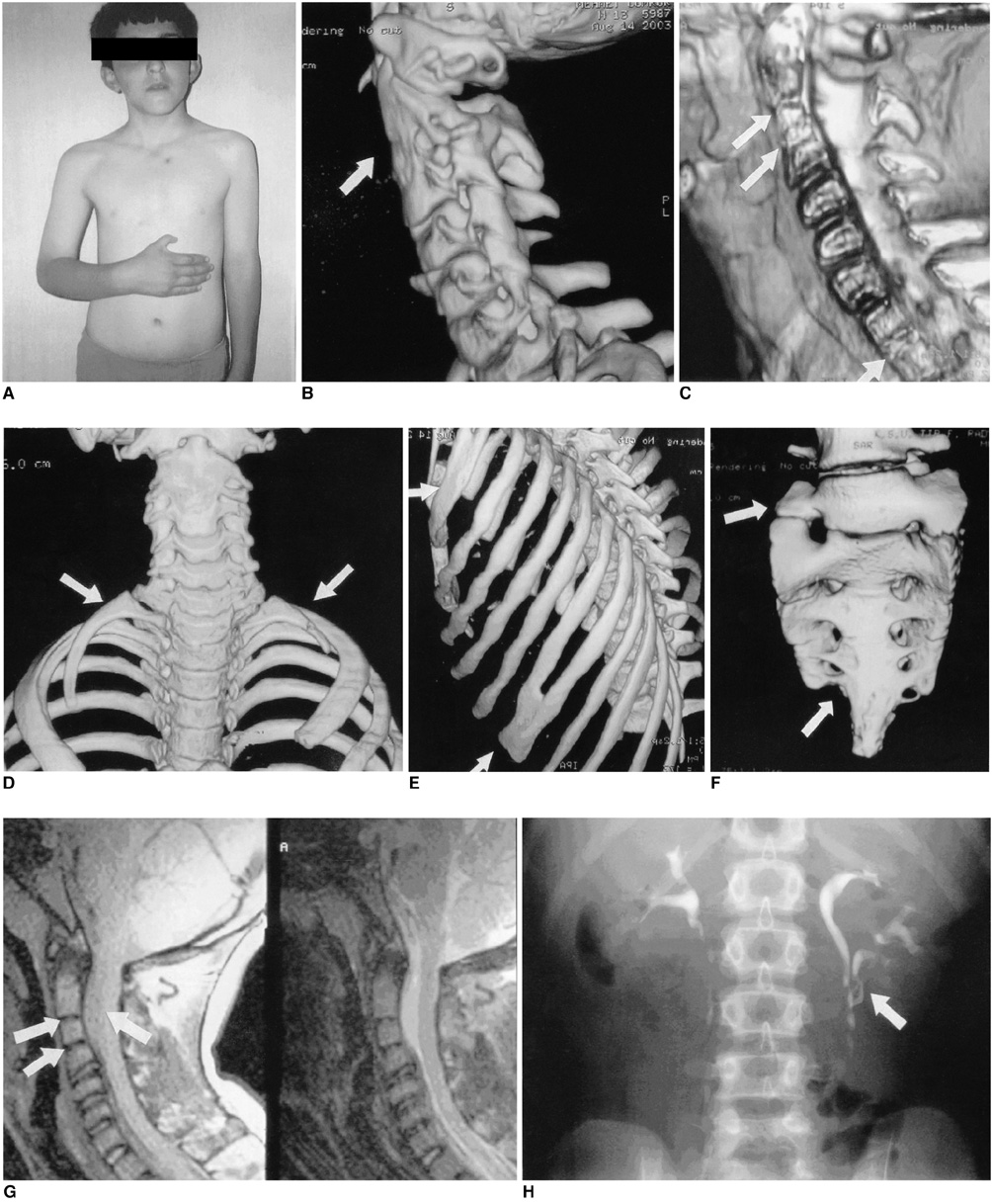Korean J Radiol.
2005 Dec;6(4):278-281. 10.3348/kjr.2005.6.4.278.
Diagnostic Importance of 3D CT Images in Klippel-Feil Syndrome with Multiple Skeletal Anomalies: A Case Report
- Affiliations
-
- 1Kahramanmaras Sutcu Imam University, Radiology Dept., Turkey. myuksel@ksu.edu.tr
- 2Kahramanmaras Sutcu Imam University, Pediatrics Dept., Turkey.
- 3Kahramanmaras Sutcu Imam University, Neuroradiology Dept., Turkey.
- KMID: 1777286
- DOI: http://doi.org/10.3348/kjr.2005.6.4.278
Abstract
- We present here the case of a 12-year-old boy who had Klippel-Feil syndrome with renal, cardiac and multiple skeletal anomalies, and we show the relevent three-dimensional computed tomography images. Our patient had a triple renal pelvis, mitral valve prolapsus, multiple cervical vertebrae fusions, cervical ribs, hypoplasia of the right thumb, spina bifida of L5, lumbalization at the right side of S1 and a sacral curved defect. In this study, we discuss the atypical clinical features and the diagnostic value of three-dimensional CT for evaluating the skeletal anomalies of the Klippel-Feil syndrome cases.
MeSH Terms
Figure
Reference
-
1. Nguyen VD, Tyrrel R. Klippel-Feil syndrome: Patterns of bony fusion and wasp-waist sign. Skeletal Radiol. 1993. 22:519–523.2. Thomsen MN, Schneider U, Weber M, Johannisson R, Niethard FU. Scoliosis and congenital anomalies associated with Klippel-Feil syndrome types I-III. Spine. 1997. 22:396–401.3. Vaidyanathan S, Hughes PL, Soni BM, Singh G, Sett P. Klippel-Feil syndrome - the risk of cervical spinal cord injury: a case report. BMC Fam Pract. 2002. 3:6.4. Pizzutillo PD, Woods M, Nicholson L, MacEwen GD. Risk factors in Klippel-Feil syndrome. Spine. 1994. 19:2110–2116.5. Dahnert W. Radiology Review Manual. 1993. 2nd ed. Maryland: Williams & Wilkins;130.6. Moore WB, Matthews TJ, Rabinowitz R. Genitourinary anomalies associated with Klippel-Feil syndrome. J Bone Joint Surg Am. 1975. 57:355–357.7. Masuda H, Arikawa K, Yuda T, Taira A. Total anomalous pulmonary venous connection associated with Klippel-Feil syndrome: a case report] (abstract). Kyobu Geka. 1991. 44:417–420.8. Algom M, Schlesinger Z. Prolapse of the mitral valve in Klippel-Feil syndrome. Chest. 1981. 79:127–128.9. Schaefer-Prokop C, von Smekal U, van der Molen AJ. Prokop M, Galanski M. Musculoskeletal system. Spiral and multislice computed tomography of the body. 2003. Stuttgart, NewYork: Thieme;929–997.10. Schlosser RJ, Faust RA, Phillips CD, Gross CW. Three-dimensional computed tomography of congenital nasal anomalies. Int J Pediatr Otorhinolaryngol. 2002. 65:125–131.
- Full Text Links
- Actions
-
Cited
- CITED
-
- Close
- Share
- Similar articles
-
- A Case of Klippel-Feil Syndrome with Recurrent Hypoglycemia
- Traumatic Hemiparesis Associated with Type III Klippel-Feil Syndrome
- Sprengel Deformity with Bilateral Huge Omovertebra
- Endotracheal Intubation Using McGrath Videolaryngoscope in Klippel-Feil Syndrome
- Progressive Quadriparesis following a Minor Trauma in a Patient with Klippel-Feil Syndrome: Case Report


